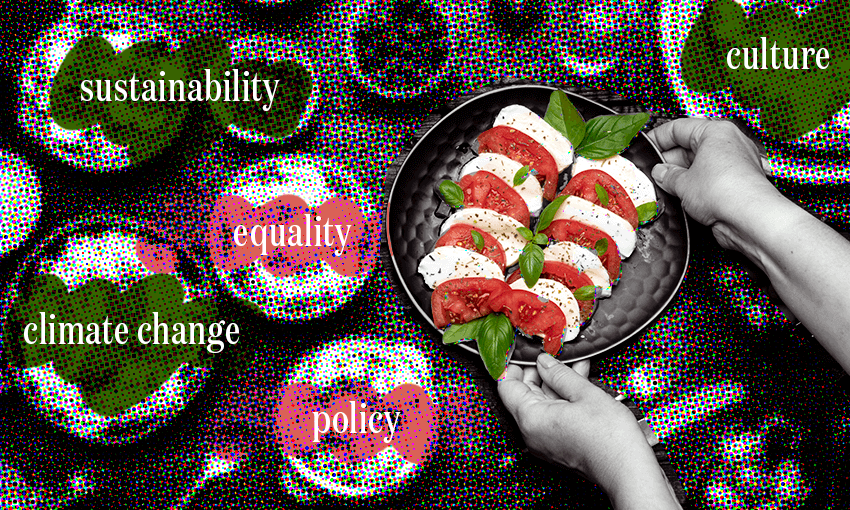With a topic so universal, it’s almost always about something bigger.
Consider the contents of your fridge. What kinds of fruits and vegetables are in your crisper drawer? How much did that block of cheese set you back? Where did you source most of this kai from? Are there ingredients in there that remind you of home? How many different countries of origin populate the shelves? Who do you share your fridge with? Is what’s in your fridge, or rather, not in your fridge, a source of anxiety? Did your bottle of milk come from a cow or a grain or a bean or a nut? Do you even buy milk, of any kind, these days?
Each of these questions might seem rather inconsequential, perhaps even a bit dreary, but their answers set the scene for understanding the world around us – far beyond our individual fridge doors. Answers to questions like these tell stories, not just of what we like to snack on while we watch our favourite television show or what we plan to cook for dinner tonight, but of who we are and our connections to everything else going on in Aotearoa and beyond.
Far more than just sustenance or something delicious, what’s on our plate defines our wellbeing; it’s an ever-changing expression of who we are as individuals and as communities and as a country; it’s long been a huge slice of our economic pie; it’s a vehicle for various social struggles; it’s central to climate change; and too many of us don’t get to enjoy our fair share of it. It’s this complex landscape of kai that we’re looking to capture in a new project at The Spinoff called What’s Eating Aotearoa. Food is a way into some of the most pressing political and social issues we face and so we want to create long-form journalism in 2024 that traverses the intersection of food with politics, culture, business and climate change.
For me, what makes thoughtful, in depth food writing so powerful is that it’s not really about food at all. What I mean by that is that food has the unique propensity to act as a bridge between everyday enjoyment and topics that might often feel too unwieldy, distant or complicated to tackle. When we delve into inequality or history or climate change or economics through the lens of kai, even the most cumbersome of topics can become bite sized, and the most seemingly boring of topics can be made digestible. And it’s never been more vital to find new and accessible ways into stories. Among what feels like a relentless dumpster fire of bleak current events, it seems more important than ever to put well-resourced, in-depth, quality food journalism on the table.
As far as bleak current events go, climate change has got to rank at the very upper end of the scale. The relentlessly grim nature of the subject means that it’s tempting to scroll right past and ignore anything that mentions those two dreaded words in the headline. But it’s in this kind of knotty area that food journalism thrives.
In the most tangible (or edible) ways, food writing provides a twofold lens at the point where our daily diet meets the realities of climate change. On one hand there is near limitless potential in stories which delve into how New Zealand’s food industry – through agriculture or horticulture or viticulture – impacts climate change and contributes to environmental degradation both here and abroad. On the other hand, there’s a necessity to investigate how the implications of climate change, like extreme weather events, drought, wildfires, floods, and warmer oceans threatens food security and our access to our favourite kinds of kai.
Just as the challenges of climate change have become ever more urgent, so too have questions around how to tackle inequality. At the same time as food prices have soared globally, discussions revolving around food inequities have become part of our ordinary. As food writing unravels the threads of how we eat, there’s potential for digging into the stories of those who profit within our food system, those who struggle to access the most basic kai necessities and the structures which allow that gap to exist in the first place.
Of course, the food we eat doesn’t just appear by magic. By delving into our local food systems it’s impossible to ignore the working conditions of the people whose time and labour gets food to our plate. We only need to look at the regularly exploitative treatment of RSE workers who pick our fruit, to the hospitality food workers whose attempts at gaining a Fair Pay Agreement look set to be dashed by a new government. Bubbling away beneath all good food writing, is the belief that we all have a right to eat well.
Our fridges, dining room tables, plates or favourite bag of chips are where our individual sense of enjoyment becomes entwined with the world around us – including all its most burdensome problems. Not only does food writing give us the tools to understand these, but it acts as a reminder that like food, the biggest challenges we face are best consumed, not alone, but around the table, together.

